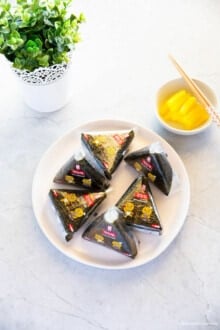Easy kimbap (Korean sushi roll) recipe!
Today I’m sharing an easy kimbap recipe. In Korea, we call it Yachae Kimbap (야채 김밥). It means vegetable kimbap and this is the most basic kimbap variety available in Korea.
While the name indicates that it’s vegetable oriented, it’s not necessarily a vegetarian kimbap.
It does include some processed meat such as Korean ham and imitation crab meat. But if you’re after vegetarian kimbap, you can simply omit these and perhaps add some cooked seasoned tofu.

This easy kimbap somewhat resembles California roll, but as you can gather they do taste different. In my opinion, easy kimbap has more savory and subtle flavor than California roll.
Anyway, kimbap is a popular picnic food in Korea. I always looked forward to my school picnic day because my mom would get up early and make these delicious rolls for me. Our kitchen smelled like toasted sesame oil all morning.
I hope you try my recipe soon!
P.S. Don’t forget to check my other kimbap recipes too! These are more fancier varieties in my opinion. Enjoy! –
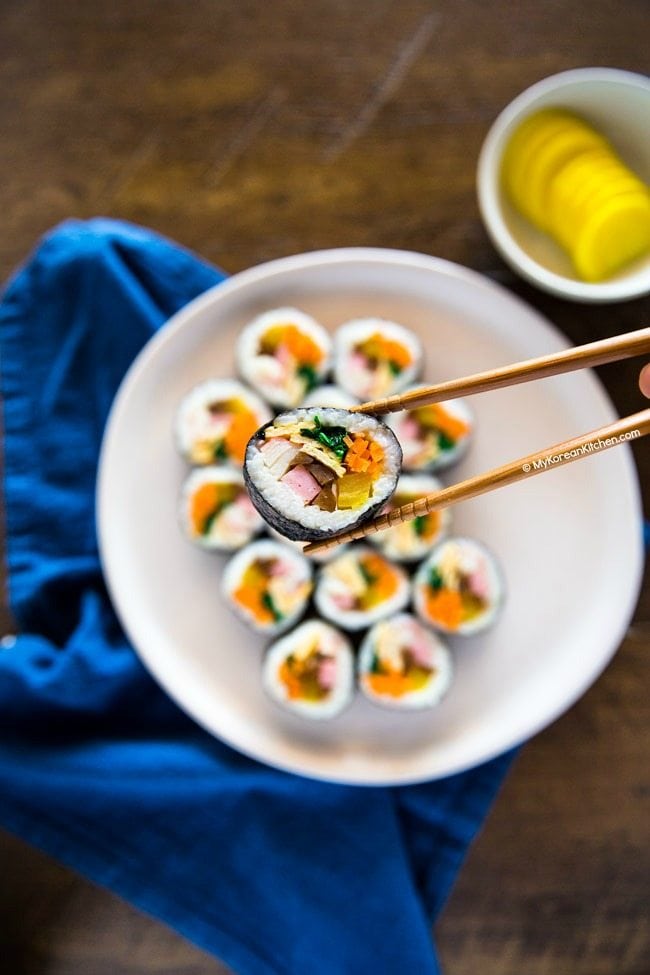
Ingredients for Easy Kimbap (Makes 4 rolls)
- 4 dried seaweed sheets (gim / sushi nori)
- 120g / 4.2 ounces spinach (regular or baby spinach)
- 2 eggs, beaten
- 1/2 carrot (120g / 4.2 ounces), julienned
- 2 to 4 imitation crab sticks (depending on the length), cut in half length ways
- 4 sticks of BBQ Kimbap ham, cut into long strips if you didn’t buy the pre-cut version (available at a Korean grocery store)
- 4 yellow radish pickle (danmuji), cut into long strips if you didn’t buy the pre-cut version (available at a Korean / Japanese grocery store)
- (optional) 12 strips seasoned edible burdock root (available at a Korean grocery store. You can buy the one that’s packaged together with yellow radish pickle like this picture. It’s also sold individually.)
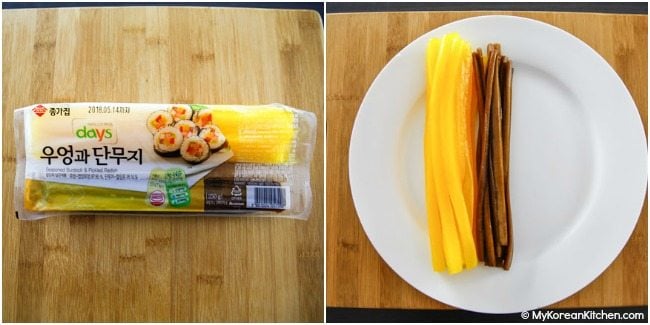
- 2 1/2 cups cooked short grain rice
- 2 Tbsp sesame oil, divided
- 3/8 tsp fine sea salt (or more to taste), divided
*1 Tbsp = 15 ml, 1 Cup = 250 ml
Alternative Ingredients / Substitution
- Spinach -> cucumber
- Korean kimbap ham -> sliced double smoked ham (no further cooking needed)
- Sliced cheese or cream cheese
- Bulgogi (Korean BBQ beef)
- Kimchi
- Yubu (inariage)
How to Make Kimbap
1. Rinse the spinach and parboil it in rapidly boiling water (30 seconds to 1 minute). Drain the water away and run some cold water over the spinach. Gently squeeze the spinach to remove any excess water. Put the spinach into a bowl. Add 1/8 tsp salt and 1/2 Tbsp sesame oil then mix them well.
2. Pre-heat a pan/skillet. Add a small dash of cooking oil and spread it around the pan. Add the beaten egg and cook both sides well over medium heat. Place the egg omelette on a cutting board and cut it into long strips.
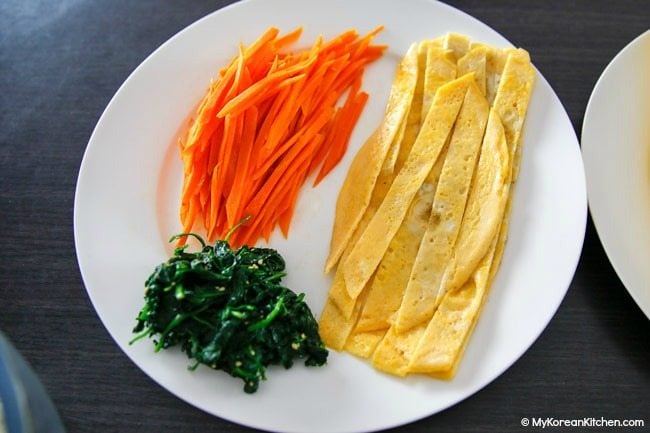
3. In a heated pan, lightly cook the carrots, crab sticks and kimbap ham (about 1 min per ingredients), separately, and over medium heat. (Some people use these raw, but I prefer cooking them first for my kimbap.)
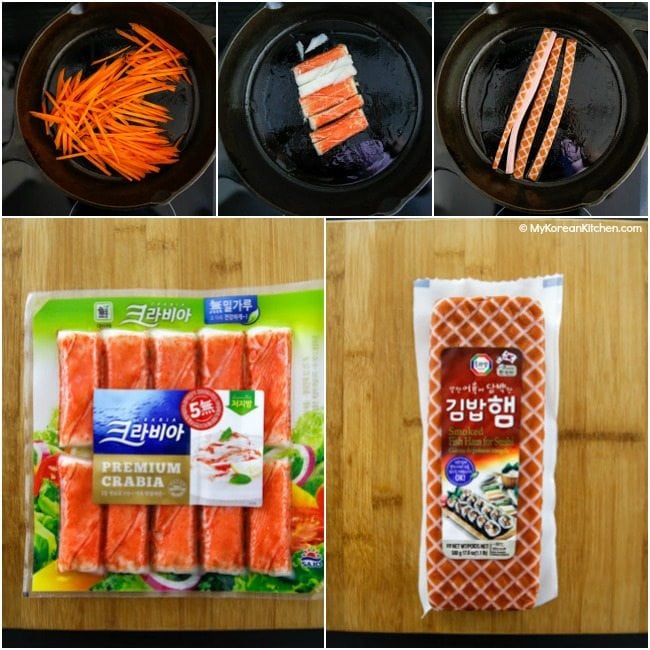
4. Place the cooked rice into a mixing bowl then add 1/2 Tbsp sesame oil and 1/4 tsp fine sea salt (or more to taste). Mix them well with a rice spatula.
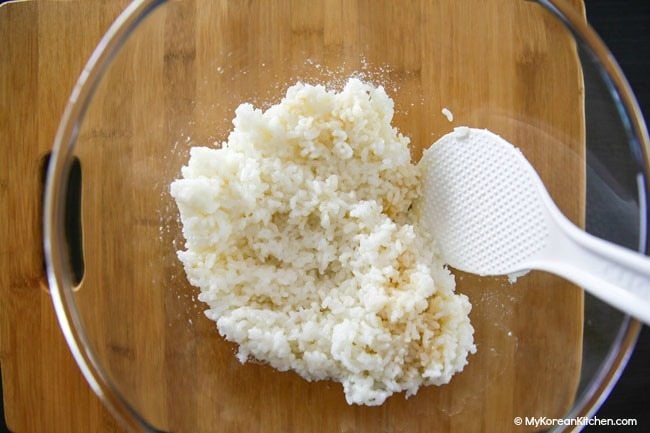
5. Gather all the kimbap ingredients at the ‘kimbap rolling station’. This makes it easy to assemble.
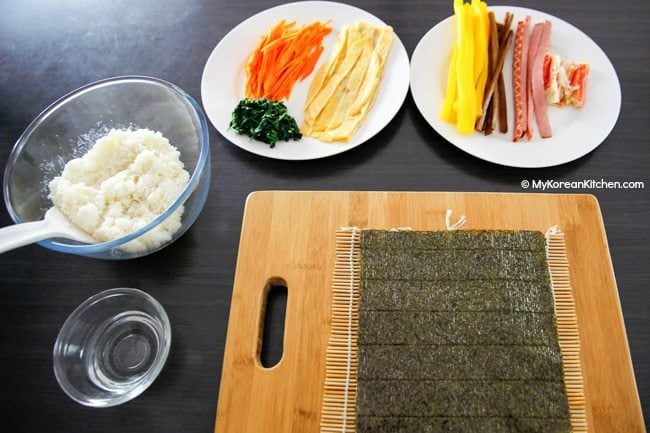
6. Place one dried seaweed sheet on the bamboo mat (shiny side down). Put the rice on the seaweed sheet then spread it evenly and thinly to cover about 2/3 of the seaweed. (Leave about 5cm / 2 inches gap at the top of the seaweed).
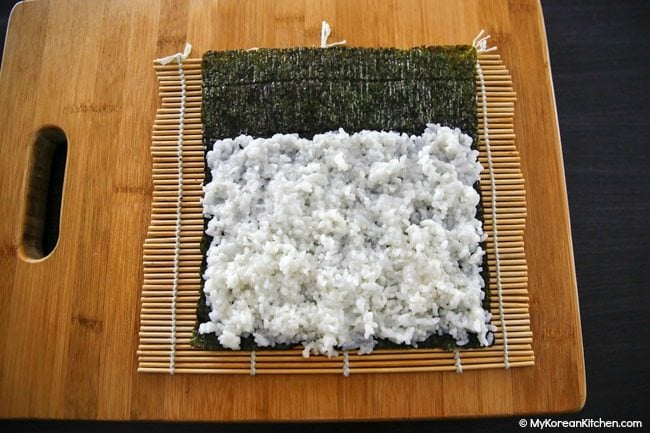
7. Now fill the seaweed with the filing ingredients. Make sure you evenly use the ingredients so that you’re not short of them later.
Watch How I Roll My Kimbap
Place one yellow radish pickle at about 1/3 point of the seaweed then add three burdock strips, one ham strip, one crab stick around it. Then pile up a few eggs strips, carrot sticks, and some spinach. Then roll the seaweed.

If the seaweed doesn’t stick, paste some water on the gap you left in step 6. You can also use a few grains of cooked rice in this gap. Set the rolled kimbap aside.
8. Repeat the step 6 and 7 with the remaining ingredients.
9. Line up all kimbap on a cutting board and paste some sesame oil (1 Tbsp) around the seaweed surface. Slice kimbap into bite size pieces. Serve.
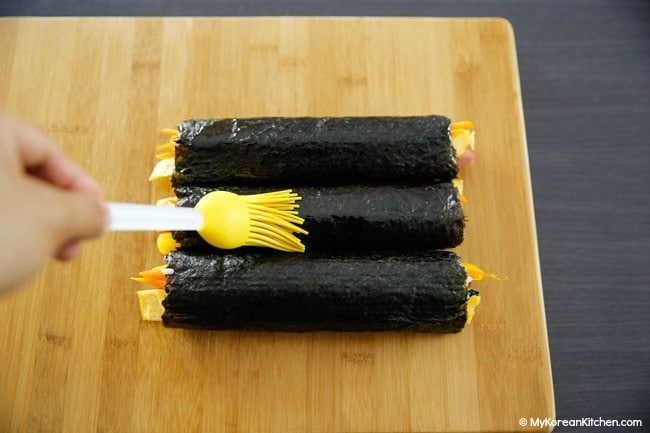
How to Serve
You normally serve kimbap with sliced yellow radish pickles. It doesn’t require a dipping sauce like sushi rolls do. However, if you want, you can serve it with some soy sauce.
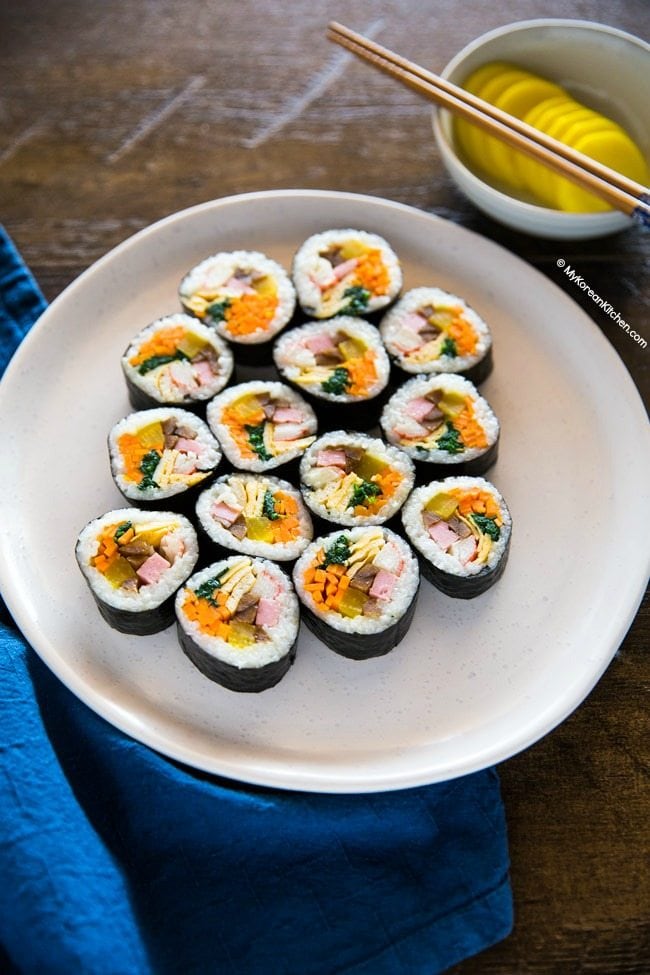
How to Store
- Sliced kimbap in an air tight container can be refrigerated for several hours without compromising the flavor and the texture. However, if you store these kimbap overnight, the rice will most likely go dry.
- If planning on eating it the next day, store kimbap unsliced and keep them well packaged in the fridge. Leave at room temperature about 30 mins prior to serving then slice. Even with this effort, kimbap rice could still go dry, but less then storing sliced kimbap. Therefore, it’s best to eat it all up on the day you make it.
- Many Koreans coat day old kimbap in beaten egg mixture and pan fry them first before eating them. It is supposed to disguise the dryness of the kimbap.
Love Korean food? Browse my other easy Korean recipes from this recipe index. And subscribe to my newsletter and follow along on Facebook, Pinterest and Instagram for all of the latest updates.

Easy Kimbap
Ingredients
- 4 dried seaweed sheets (gim / sushi nori)
- 120 g spinach (4.2 ounces), regular or baby spinach
- 2 eggs , beaten
- 1/2 carrot (120g / 4.2 ounces), julienned
- 2 to 4 imitation crab sticks (depending on the length), cut in half length ways
- 4 sticks BBQ Kimbap ham , cut into long strips if you didn’t buy the pre-cut version (available at a Korean grocery store)
- 4 yellow radish pickle (danmuji), cut into long strips if you didn’t buy the pre-cut version (available at a Korean / Japanese grocery store)
- 12 strips seasoned edible burdock root (optional), (available at a Korean grocery store. You can buy the one that’s packaged together with yellow radish pickle like this picture. It’s also sold individually.)
- 2 1/2 cups steamed short grain rice
- 2 Tbsp sesame oil , divided
- 3/8 tsp fine sea salt (or more to taste), divided
Instructions
- Rinse the spinach and parboil it in rapidly boiling water (30 seconds to 1 minute). Drain the water away and run some cold water over the spinach. Gently squeeze the spinach to remove any excess water. Put the spinach into a bowl. Add 1/8 tsp salt and 1/2 Tbsp sesame oil then mix them well.
- Pre-heat a pan/skillet. Add a small dash of cooking oil and spread it around the pan. Add the beaten egg and cook both sides well over medium heat. Place the egg omelette on a cutting board and cut it into long strips.
- In a heated pan, lightly cook the carrots, crab sticks and kimbap ham (about 1 min per ingredients), separately, and over medium heat. (Some people use these raw, but I prefer cooking them first for my kimbap.)
- Place the cooked rice into a mixing bowl then add 1/2 Tbsp sesame oil and 1/4 tsp fine sea salt (or more to taste). Mix them well with a rice spatula.
- Gather all the kimbap ingredients at the ‘kimbap rolling station’. This makes it easy to assemble.
- Place one dried seaweed sheet on the bamboo mat (shiny side down). Put the rice on the seaweed sheet then spread it evenly and thinly to cover about 2/3 of the seaweed. (Leave about 5cm / 2 inches gap at the top of the seaweed).
- Now fill the seaweed with the filing ingredients. Make sure you evenly use the ingredients so that you’re not short of them later.
Here’s how I do it. (A short video instruction within the post above.) Place one yellow radish pickle at about 1/3 point of the seaweed then add three burdock strips, one ham strip, one crab stick around it. Then pile up a few eggs strips, carrot sticks, and some spinach. Then roll the seaweed.
If the seaweed doesn’t stick, paste some water on the gap you left in step 6. You can also use a few grains of cooked rice in this gap. Set the rolled kimbap aside. - Repeat the step 6 and 7 with the remaining ingredients.
- Line up all kimbap on a cutting board and paste some sesame oil (1 Tbsp) around the seaweed surface. Slice kimbap into bite size pieces. Serve.
Nutrition Info (per serving)
The nutrition information shown is an estimate provided by an online nutrition calculator. It should not be considered a substitute for a professional nutritionist’s advice.



